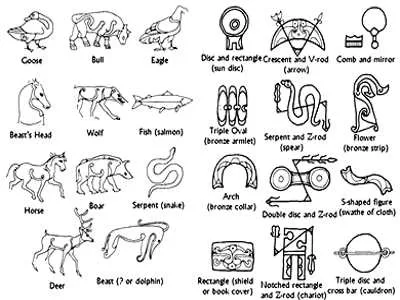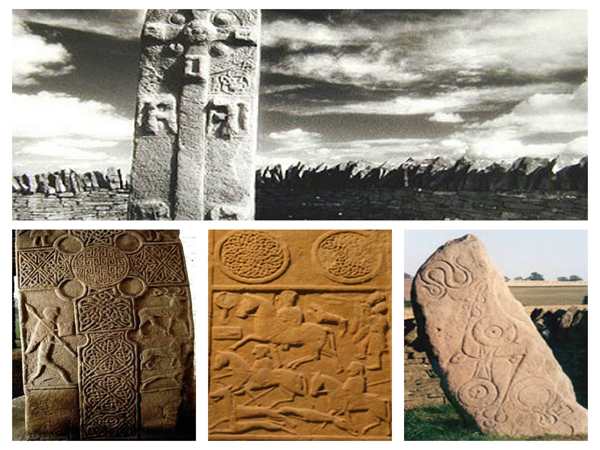For centuries, enigmatic carvings adorned the Pictish Stones of Scotland, baffling scholars. Now, groundbreaking research suggests these stylized engravings aren’t mere art, but a lost language.
The Picts, a Celtic people who thrived in Scotland from the 3rd to 9th centuries, have left an enduring mystery. Their culture, once shrouded in obscurity, is gradually revealing its secrets. Recent findings have unveiled a startling truth about the iconic Pictish Stones.
Researchers have long pondered the meaning behind the intricate designs etched into these ancient monoliths. Initially dismissed as decorative or symbolic, these engravings have now been classified as a written language. A team led by Professor Rob Lee from the University of Exeter employed advanced mathematical techniques to analyze the patterns within the carvings. Their findings, published in the Proceedings of the Royal Society A, challenge conventional wisdom.
By comparing the Pictish symbols to known writing systems, such as hieroglyphs and early Latin, the researchers identified characteristics indicative of a spoken language. The data revealed a systematic structure and order, suggesting a complex linguistic foundation.
While the Pictish language remains undeciphered, the symbols offer tantalizing clues. Depictions of animals, weapons, and human figures may represent words or concepts. Some engravings resemble Celtic knots, hinting at potential connections to other early European scripts.

The discovery of a Pictish writing system is a monumental leap forward in understanding this enigmatic culture. It opens doors to exploring their social structures, beliefs, and interactions with neighboring societies. However, deciphering the language will be a formidable challenge, akin to cracking the code of ancient Egyptian hieroglyphs.
As the research unfolds, experts anticipate a surge of interest in Pictish studies. Archaeologists, linguists, and historians are eager to contribute to unraveling this linguistic puzzle. The potential rewards are immense, promising to rewrite chapters of Scottish history.
With each new discovery, the Picts emerge from the shadows, revealing a sophisticated society with a rich cultural heritage. The journey to fully comprehend their language may be long and arduous, but the prospect of unlocking their secrets is an exhilarating adventure for scholars and history enthusiasts alike.
Scotland’s Prehistoric Roots
Long before recorded history, Scotland teemed with life. Hunter-gatherers roamed its lands, their footprints etched into the earth as they sought sustenance. Evidence of these early inhabitants, such as stone tools and remnants of settlements, offers tantalizing glimpses into their world. As millennia passed, the landscape transformed, and with it, the way of life. Farming communities emerged, cultivating the land and building enduring structures.
The Age of Celts and Picts
The Iron Age marked a pivotal chapter in Scotland’s history. Celtic tribes, renowned for their artistry and warrior spirit, made their mark on the land. Their influence is evident in the intricate patterns adorning ancient artifacts and the enduring legacy of Celtic traditions. Coexisting with the Celts were the enigmatic Picts, whose name, meaning “painted people,” hints at their distinctive cultural practices. Their legacy is most vividly captured in the iconic standing stones that dot the Scottish countryside.
Roman Encounters and Resistance
The Roman Empire’s shadow extended north, but Scotland proved an indomitable foe. The Caledonians, a fierce coalition of tribes, repelled Roman invasions, leaving their mark on history through legendary figures like the warrior queen Boudica. While the Romans never fully conquered Scotland, their presence influenced the region, leaving behind remnants of forts and roads.
The Birth of Kingdoms
As the Roman Empire waned, a patchwork of kingdoms emerged across Scotland. The Scots, originally from Ireland, established a presence in the west, while the Picts held sway in the north. Through a complex interplay of alliances, conflicts, and cultural exchange, these kingdoms evolved, ultimately culminating in the unification of Scotland under one crown.
Scotland’s Stone Legacy
Scotland’s ancient past is indelibly linked to its extraordinary stone heritage. From the megalithic wonders of the Neolithic period to the intricate carvings on Pictish symbol stones, these monuments stand as testaments to the ingenuity and spiritual beliefs of Scotland’s ancestors. The standing stones at Callanish, the mysterious structures of Orkney, and the enigmatic Pictish stones at Aberlem continue to captivate and inspire.
Exploring Scotland’s ancient history is to embark on a journey through time, connecting with the lives and legacies of those who came before. The land itself is a living archive, with every hill, valley, and coastline holding stories waiting to be uncovered.

